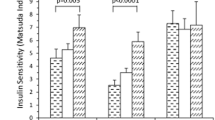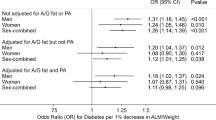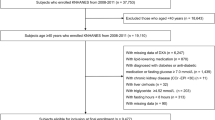Abstract
Objective:
To compare the relationships between markers of total and regional adiposity with muscle fat infiltration in type 1 diabetic and type 2 diabetic subjects and their respective nondiabetic controls, and to document these relationships in type 1 diabetic subjects.
Design:
Cross-sectional study.
Subjects:
In total, 86 healthy, with type 1 diabetes, type 2 diabetes or control subjects. Each diabetic group was matched for age, sex and body mass index with its respective nondiabetic control group.
Measurements:
Measures of body composition (hydrodensitometry), fat distribution (waist circumference, abdominal and mid-thigh computed tomography scans) and blood lipid profiles were assessed.
Results:
Low attenuation mid-thigh muscle surface correlated similarly with markers of adiposity and body composition in all groups, regardless of diabetes status, except for visceral adipose tissue and waist circumference. Indeed, relationships between visceral adiposity and muscle adiposity were significantly stronger in type 2 vs type 1 diabetic subjects (P<0.05 for comparison of slopes). In addition, in well-controlled type 1 diabetic subjects (mean HbA1c of 6.8%), daily insulin requirements tended to correlate with low attenuation mid-thigh muscle surface, a specific component of fat-rich muscle (r=0.36, P=0.08), but not with glycemic control (HbA1c).
Conclusion:
This study suggests that the relationship of central adiposity and muscle adiposity is modulated by diabetes status and is stronger in the insulin resistant diabetes type (type 2 diabetes). In well-controlled nonobese type 1 diabetic subjects, the relationship between muscle fat accumulation and insulin sensitivity was also maintained.
This is a preview of subscription content, access via your institution
Access options
Subscribe to this journal
Receive 12 print issues and online access
$259.00 per year
only $21.58 per issue
Buy this article
- Purchase on Springer Link
- Instant access to full article PDF
Prices may be subject to local taxes which are calculated during checkout

Similar content being viewed by others
Abbreviations
- AT:
-
adipose tissue
- CT:
-
computed tomography
- FFM:
-
fat-free mass
- FM:
-
fat mass
- IMCL:
-
intramyocellular lipid content
- SAT:
-
subcutaneous adipose tissue
- TAT:
-
total adipose tissue
- VAT:
-
visceral adipose tissue
- WC:
-
waist circumference.
References
Goldstein BJ . Insulin resistance as the core defect in type 2 diabetes mellitus. Am J Cardiol 2002; 90: 3G–10G.
Goodpaster BH, Thaete FL, Kelley DE . Composition of skeletal muscle evaluated with computed tomography. Ann NY Acad Sci 2000; 904: 18–24.
Itani SI, Ruderman NB, Schmieder F, Boden G . Lipid-induced insulin resistance in human muscle is associated with changes in diacylglycerol, protein kinase C, and IkappaB-alpha. Diabetes 2002; 51: 2005–2011.
Gan SK, Kriketos AD, Poynten AM, Furler SM, Thompson CH, Kraegen EW et al. Insulin action, regional fat, and myocyte lipid: altered relationships with increased adiposity. Obes Res 2003; 11: 1295–1305.
Bushberg JT, Seibert JA, Leidholdt EMJ, Boone JM . X-Ray computed tomography. In: Passano WM (eds). The Essentials of Medical Imaging. Williams et Wilkins: Baltimore, MD, 1994, pp 239–289.
Goodpaster BH, Brown NF . Skeletal muscle lipid and its association with insulin resistance: What is the role for exercise? Exerc Sport Sci Rev 2005; 33: 150–154.
Goodpaster BH, Thaete FL, Simoneau JA, Kelley DE . Subcutaneous abdominal fat and thigh muscle composition predict insulin sensitivity independently of visceral fat. Diabetes 1997; 46: 1579–1585.
Yki-Jarvinen H, Helve E, Koivisto VA . Hyperglycemia decreases glucose uptake in type I diabetes. Diabetes 1987; 36: 892–896.
Rossetti L, Smith D, Shulman GI, Papachristou D, DeFronzo RA . Correction of hyperglycemia with phlorizin normalizes tissue sensitivity to insulin in diabetic rats. J Clin Invest 1987; 79: 1510–1515.
Rossetti L, Giaccari A, DeFronzo RA . Glucose toxicity. Diabetes Care 1990; 13: 610–630.
Perseghin G, Lattuada G, Danna M, Sereni LP, Maffi P, De Cobelli F et al. Insulin resistance, intramyocellular lipid content, and plasma adiponectin in patients with type 1 diabetes. Am J Physiol Endocrinol Metab 2003; 285: E1174–E1181. E-pub 2003 August 1121.
Ebeling P, Essen-Gustavsson B, Tuominen JA, Koivisto VA . Intramuscular triglyceride content is increased in IDDM. Diabetologia 1998; 41: 111–115.
The Expert Committee on the Diagnosis and Classification of Diabetes Mellitus. American diabetes association: clinical practice recommendations 2002. Diabetes Care 2002; 25 (Suppl 1): S1–S147.
Matthews DR, Hosker JP, Rudenski AS, Naylor BA, Treacher DF, Turner RC . Homeostasis model assessment: insulin resistance and beta-cell function from fasting plasma glucose and insulin concentrations in man. Diabetologia 1985; 28: 412–419.
Callaway WC, Chumlea WC, Bouchard C, Himes JH, Lohman TG, Martin AD et al. Circumferences. In: Lohman TG, Roche AF, Martorel R (eds). Anthropometric Standardization Reference Manual. Human Kinetic Books: Champaign, IL, 1988, pp 39–80.
Meneely E, Kaltreider N . Volume of the lung determined by helium dilution. J Clin Invest 1949; 28: 129–139.
Behnke A, Wilmore J . Evaluation and regulation of body build and composition. Prentice-Hall: Englewood Cliffs, NJ, 1974, pp 20–37.
Siri WE . The gross composition of the body. Adv Biol Med Phys 1956; 4: 239–280.
Sjostrom L, Kvist H, Cederblad A, Tylen U . Determination of total adipose tissue and body fat in women by computed tomography, 40 k, and tritium. Am J Physiol 1986; 250: E736–E745.
Buckley DC, Kudsk KA, Rose BS, Fatzinger P, Koetting CA, Schlatter M . Anthropometric and computerized tomographic measurements of lower extremity lean body mass. J Am Diet Assoc 1987; 87: 196–199.
Kelley DE, Slasky BS, Janosky J . Skeletal muscle density: effects of obesity and non-insulin-dependent diabetes mellitus. Am J Clin Nutr 1991; 54: 509–515.
Perusse L, Rice T, Despres JP, Bergeron J, Province MA, Gagnon J et al. Familial resemblance of plasma lipids, lipoproteins and postheparin lipoprotein and hepatic lipases in the HERITAGE Family Study. Arterioscler Thromb Vasc Biol 1997; 17: 3263–3269.
Lemieux I, Lamarche B, Couillard C, Pascot A, Cantin B, Bergeron J et al. Total cholesterol/HDL cholesterol ratio vs LDL cholesterol/HDL cholesterol ratio as indices of ischemic heart disease risk in men: the Quebec Cardiovascular Study. Arch Intern Med 2001; 161: 2685–2692.
Snedecor G, Cochran WG . Analysis of covariance. Statistical Methods, 6th edn. Iowa State University Press, 1967, pp 419–446.
Hirsch IB . Type 1 diabetes mellitus and the use of flexible insulin regimens. Am Fam Physician 1999; 60: 2343–2352, 2355–2346.
Hulver MW, Dohm GL . The molecular mechanism linking muscle fat accumulation to insulin resistance. Proc Nutr Soc 2004; 63: 375–380.
Sinha R, Dufour S, Petersen KF, LeBon V, Enoksson S, Ma YZ et al. Assessment of skeletal muscle triglyceride content by (1)H nuclear magnetic resonance spectroscopy in lean and obese adolescents: relationships to insulin sensitivity, total body fat, and central adiposity. Diabetes 2002; 51: 1022–1027.
Standl E, Lotz N, Dexel T, Janka HU, Kolb HJ . Muscle triglycerides in diabetic subjects. Effect of insulin deficiency and exercise. Diabetologia 1980; 18: 463–469.
Perseghin G, Scifo P, De Cobelli F, Pagliato E, Battezzati A, Arcelloni C et al. Intramyocellular triglyceride content is a determinant of in vivo insulin resistance in humans: a 1H–13C nuclear magnetic resonance spectroscopy assessment in offspring of type 2 diabetic parents. Diabetes 1999; 48: 1600–1606.
Acknowledgements
We thank Lucie Allard, Guy Fournier, Geneviève Landry and Martin Milot for their precious technical assistance. This work was supported by Diabète Québec and the Canadian Institutes of Health Research (MT-13960 and GR-15187).
Author information
Authors and Affiliations
Corresponding author
Rights and permissions
About this article
Cite this article
Dubé, M., Joanisse, D., Prud'homme, D. et al. Muscle adiposity and body fat distribution in type 1 and type 2 diabetes: varying relationships according to diabetes type. Int J Obes 30, 1721–1728 (2006). https://doi.org/10.1038/sj.ijo.0803337
Received:
Revised:
Accepted:
Published:
Issue Date:
DOI: https://doi.org/10.1038/sj.ijo.0803337
Keywords
This article is cited by
-
Aging adipose tissue, insulin resistance, and type 2 diabetes
Biogerontology (2024)
-
Dual X-ray absorptiometry body composition and its associated factors in children and adolescence with type 1 diabetes mellitus in South of Iran, a case-control study
International Journal of Diabetes in Developing Countries (2017)
-
Why should people with type 1 diabetes exercise regularly?
Acta Diabetologica (2017)
-
Accelerated atrophy of lower leg and foot muscles—a follow-up study of long-term diabetic polyneuropathy using magnetic resonance imaging (MRI)
Diabetologia (2009)
-
Fat Infiltration in Muscle: New Evidence for Familial Clustering and Associations With Diabetes
Obesity (2008)



